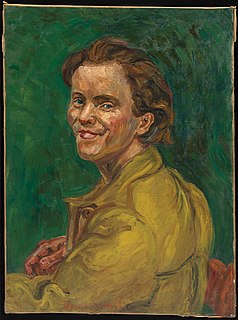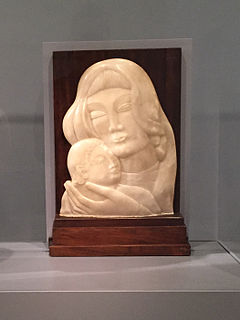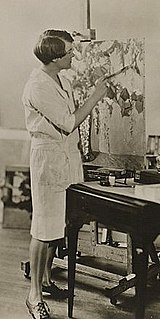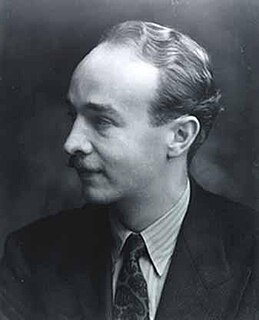
Morgan Russell was a modern American artist. With Stanton Macdonald-Wright, he was the founder of Synchromism, a provocative style of abstract painting that dates from 1912 to the 1920s. Russell's "synchromies," which analogized color to music, were an early American contribution to the rise of Modernism.

The Ashcan School, also called the Ash Can School, was an artistic movement in the United States during the late 19th-early 20th century that produced works portraying scenes of daily life in New York, often in the city's poorer neighborhoods.

Max Weber was a Jewish-American painter and one of the first American Cubist painters who, in later life, turned to more figurative Jewish themes in his art. He is best known today for Chinese Restaurant (1915), in the collection of the Whitney Museum of American Art, "the finest canvas of his Cubist phase," in the words of art historian Avis Berman.

Robert Laurent was a French-American modernist figurative sculptor, printmaker and teacher. His work, the New York Times wrote,"figured in the development of an American sculptural art that balanced nature and abstraction." Widely exhibited, he took part in the Whitney's 1946 exhibition Pioneers of Modern Art. Credited as the first American sculptor to adopt a "direct carving" sculpting style that was bolder and more abstract than the then traditional fine arts practice, which relied on models, Laurent's approach was inspired by the African carving and European avant-garde art he admired, while also echoing folk styles found both in the U.S. and among medieval stone cutters of his native Brittany. Best known for his virtuoso mastery of the figure, Laurent sculpted in multiple media, including wood, alabaster, bronze, marble and aluminum. His expertise earned him major commissions for public sculpture, most famously for the Goose Girl for New York City's Radio City Music Hall, as well as for Spanning the Continent for Philadelphia's Fairmount Park. After the Depression, he was also the recipient of several Works Progress Administration (WPA) Federal Art Project commissions under the New Deal, including a bas-relief called Shipping for the exterior of Washington, D.C.'s Federal Trade Commission Building, commissioned by the Treasury Department’s Section of Fine Arts in 1938.

Charles Herbert Woodbury, was an American marine painter.

Theodore Robinson was an American painter best known for his Impressionist landscapes. He was one of the first American artists to take up Impressionism in the late 1880s, visiting Giverny and developing a close friendship with Claude Monet. Several of his works are considered masterpieces of American Impressionism.

William James Glackens was an American realist painter and one of the founders of the Ashcan School, which rejected the formal boundaries of artistic beauty laid-down by the conservative National Academy of Design. He is also known for his work in helping Albert C. Barnes to acquire the European paintings that form the nucleus of the famed Barnes Foundation in Philadelphia. His dark-hued, vibrantly painted street scenes and depictions of daily life in pre-WW I New York and Paris first established his reputation as a major artist. His later work was brighter in tone and showed the strong influence of Renoir. During much of his career as a painter, Glackens also worked as an illustrator for newspapers and magazines in Philadelphia and New York City.

Alfred Henry Maurer was an American modernist painter. He exhibited his work in avant-garde circles internationally and in New York City during the early twentieth century. Highly respected today, his work met with little critical or commercial success in his lifetime, and he died, a suicide, at the age of sixty-four.

Walter Francis Kuhn was an American painter and an organizer of the famous Armory Show of 1913, which was America's first large-scale introduction to European Modernism.

Samuel Halpert was an American painter.

Jane Peterson (1876–1965) was a graduate of Pratt Institute and an American Impressionist and Expressionist painter. Her works are created in Impressionist and Expressionist styles using broad swaths of vibrant colors to combine an interest in light and in depiction of spontaneous moments and are well known for vivid, rich painted still life, beach scenes along the Massachusetts coast. Her works are housed in museums such as the Metropolitan Museum of Art, the Museum of the City of New York, the National Museum of Women in the Arts and Hirshhorn Museum in Washington D.C, and Pennsylvania Academy of Fine Arts and Philadelphia Museum of Arts in Philadelphia, Pennsylvania.

Soren Emil Carlsen was an American Impressionist painter who emigrated to the United States from Denmark. He became known for his still lifes. Later in his career, Carlsen expanded his range of subjects to include landscapes and seascapes as well.

John Koch, , was an American painter and teacher, and an important figure in 20th century Realism. He is best known for his light-filled paintings of urban interiors, often featuring classical allusions, many set in his own Manhattan apartment.
Israel Levitan was an American abstract expressionist sculptor, born in Lawrence, Massachusetts. Known as a sculptor, he also produced paintings, graphics and fine art works on paper.
Charles Seliger was an American abstract expressionist painter. He was born in Manhattan June 3, 1926, and he died on 1 October 2009, in Westchester County, New York. Seliger was one of the original generation of abstract expressionist painters connected with the New York School.
George Earl Ortman was an American painter, printmaker, constructionist and sculptor. His work has been referred to as Neo-Dada, pop art, minimalism and hard-edge painting. His constructions, built with a variety of materials and objects, deal with the exploration off visual language derived from geometry—geometry as symbol and sign.

Karl Knaths was an American artist whose personal approach to the Cubist aesthetic led him to create paintings which, while abstract, contained readily identifiable subjects. In addition to the Cubist painters, his work shows influence by Paul Cézanne, Wassily Kandinsky, Utagawa Kuniyoshi, Paul Klee, Stuart Davis, and Agnes Weinrich. It is nonetheless, in use of heavy line, rendering of depth, disciplined treatment of color, and architecture of planes, distinctly his own.
John Millard Ferren was an American artist and educator. He was active from 1920 until 1970 in San Francisco, Paris and New York City.

Walter Elmer Schofield was an American Impressionist landscape and marine painter. Although he never lived in New Hope or Bucks County, Schofield is regarded as one of the Pennsylvania Impressionists.
Eugene Paul Ullman was an American Impressionist painter.















